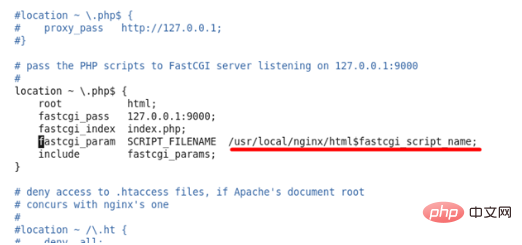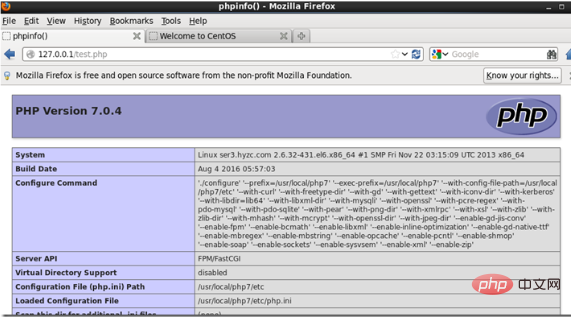How to install and configure PHP+Nginx on Linux
How to install and configure PHP Nginx on Linux: first install PHP; then install Nginx; then Nginx and PHP complete data requests through the 9000 port of the machine; and finally complete the test.

Linux installation and configuration method of PHP Nginx:
1. PHP installation
1. Install php7.0
Software download # wget http://cn2.php.net/distributions/php-7.0.4.tar.gz
Check and install dependent packages
[root@ser3 Desktop]# rpm -qa libjpeg libjpeg-devel libpng libpng-devel freetype freetype-devel libxml2 curl-devel libxslt-devel openssl-devel [root@ser3 Desktop]# yum -y install libjpeg libjpeg-devel libpng libpng-devel freetype freetype-devel libxml2 libxslt-devel openssl-devel [root@ser3 Desktop]# tar xf php-7.0.4.tar.gz [root@ser3 Desktop]# cd php-7.0.4 [root@ser3 php-7.0.4]# ./configure --prefix=/usr/local/php7 --exec-prefix=/usr/local/php7 --with-config-file-path=/usr/local/php7/etc --with-curl --with-freetype-dir --with-gd --with-gettext --with-iconv-dir --with-kerberos --with-libdir=lib64 --with-libxml-dir --with-mysqli --with-openssl --with-pcre-regex --with-pdo-mysql --with-pdo-sqlite --with-pear --with-png-dir --with-xmlrpc --with-xsl --with-zlib --with-zlib-dir --with-mhash --with-mcrypt --with-openssl-dir --with-jpeg-dir --enable-gd-jis-conv --enable-fpm --enable-bcmath --enable-libxml --enable-inline-optimization --enable-gd-native-ttf --enable-mbregex --enable-mbstring --enable-opcache --enable-pcntl --enable-shmop --enable-soap --enable-sockets --enable-sysvsem --enable-xml --enable-zip [root@ser3 php-7.0.4]# make [root@ser3 php-7.0.4]# make test [root@ser3 php-7.0.4]# make install
2. Set up the configuration file
[root@ser3 php-7.0.4]# cp php.ini-production /usr/local/php7/etc/php.ini
php.ini-development Suitable for development Testing, such as local testing environment, php.ini-production has higher security settings, suitable for server online operation as a product. Generally, modify php.ini-production to php.ini, which is more secure and ensures that the test environment (local) and the official environment (online) are consistent
[root@ser3 php-7.0.4]# cp /usr/local/php7/etc/php-fpm.conf.default /usr/local/php7/etc/php-fpm.conf [root@ser3 php-7.0.4]# cp /usr/local/php7/etc/php-fpm.d/www.conf.default /usr/local/php7/etc/php-fpm.d/www.conf [root@ser3 php-7.0.4]# cp ./sapi/fpm/init.d.php-fpm /etc/init.d/php-fpm
3. Join the startup service
[root@ser3 php-7.0.4]# chmod +x /etc/init.d/php-fpm [root@ser3 php-7.0.4]# chkconfig --add php-fpm
Note that the www.conf configuration file in php7 configures the port number and other information of phpfpm. If you modify the default 9000 port number, you need to change it here, and then change the nginx configuration
4. Start the php service
[root@ser3 php-7.0.4]# /etc/init.d/php-fpm start [root@ser3 php-7.0.4]# ps -ef | grep php-fpm
2. Nginx installation
1 .Software download:
wget http://nginx.org/download/nginx-1.6.2.tar.gz Directly use the command to download on Linux
2. Install dependencies Package pcre and dependent software
Before installing nginx, make sure you have installed# rpm -qa gcc openssl-devel pcre zlib-develSoftware library
Installing the pcre library is to enable Nginx Supports HTTP Rewriter module. If pcre does not have this installation package by default, you need to download and install it manually.
3. Optimize the installation package before installation
(Compilation and installation process optimization) Reduce the size of the compiled nginx file. When compiling nginx, the default In debug mode, a lot of tracking and ASSERT information will be inserted. After the compilation is completed,
[root@svr1 nginx-1.6.2]# vim auto/cc/gcc # debug CFLAGS="$CFLAGS -g" 注释或删除这两行,即可取消debug模式. [root@svr1 nginx-1.6.2]# ./configure --prefix=/usr/local/nginx --with-http_stub_status_module --with-http_gzip_static_module --with-openssl=/usr/local/openssl [root@svr1 nginx-1.6.2]# make && make install [root@svr1 nginx-1.6.2]# ps -ef | grep nginx [root@svr1 nginx-1.6.2]# /usr/local/nginx/sbin/nginx -c /usr/local/nginx/conf/nginx.conf [root@svr1 nginx-1.6.2]# curl -i 127.0.0.1 ...... <body> <h1 id="Welcome-nbsp-to-nbsp-nginx">Welcome to nginx!</h1> If you see this page, the nginx web server is successfully installed and ......
The test i page will show that there is no problem with the nginx installation
3. Integrate Nginx and PHP
Nginx itself does not process requests for dynamic web pages, and Nginx transfers the dynamic requests to PHP. Nginx configuration file
# vim /usr/local/nginx/conf/nginx.conf //标的部分是我们后面要修改的

Looking at the picture above, Nginx already knows how to convey the request to PHP. When Nginx gets the *.php request, it will pass the request to PHP through port 9000. Now we can just remove these comments, as shown in the picture below

As shown in the picture above, we have seen before that Nginx requests PHP through the 9000 port of the machine. Forwarded to PHP, and in the picture above we can see that PHP listens to data from the 9000 port of the local machine, and Nginx and PHP complete the data request through the 9000 port of the local machine.
4. Test
We have defined the storage path of the PHP website in the nginx configuration file. The path is /usr /local/nginx/html
Let’s create a new PHP page test page in this directory. The file name is test.php and the content is as follows
<?php
phpinfo();
?>
关闭php
killall php-fpm
php重启
/usr/local/php7/sbin/php-fpm &
关闭nginx
/usr/local/nginx/sbin/nginx -s stop //关闭服务器
重启nginx
/usr/local/nginx/sbin/nginx 开启服务器After restarting PHP and nginx, we Enter http://localhost/test.php in the browser. If the following interface appears, it is considered successful.

Related learning recommendations: PHP programming from entry to proficiency
The above is the detailed content of How to install and configure PHP+Nginx on Linux. For more information, please follow other related articles on the PHP Chinese website!

Hot AI Tools

Undresser.AI Undress
AI-powered app for creating realistic nude photos

AI Clothes Remover
Online AI tool for removing clothes from photos.

Undress AI Tool
Undress images for free

Clothoff.io
AI clothes remover

Video Face Swap
Swap faces in any video effortlessly with our completely free AI face swap tool!

Hot Article

Hot Tools

Notepad++7.3.1
Easy-to-use and free code editor

SublimeText3 Chinese version
Chinese version, very easy to use

Zend Studio 13.0.1
Powerful PHP integrated development environment

Dreamweaver CS6
Visual web development tools

SublimeText3 Mac version
God-level code editing software (SublimeText3)

Hot Topics
 1664
1664
 14
14
 1423
1423
 52
52
 1321
1321
 25
25
 1269
1269
 29
29
 1249
1249
 24
24
 Linux Architecture: Unveiling the 5 Basic Components
Apr 20, 2025 am 12:04 AM
Linux Architecture: Unveiling the 5 Basic Components
Apr 20, 2025 am 12:04 AM
The five basic components of the Linux system are: 1. Kernel, 2. System library, 3. System utilities, 4. Graphical user interface, 5. Applications. The kernel manages hardware resources, the system library provides precompiled functions, system utilities are used for system management, the GUI provides visual interaction, and applications use these components to implement functions.
 Docker on Linux: Containerization for Linux Systems
Apr 22, 2025 am 12:03 AM
Docker on Linux: Containerization for Linux Systems
Apr 22, 2025 am 12:03 AM
Docker is important on Linux because Linux is its native platform that provides rich tools and community support. 1. Install Docker: Use sudoapt-getupdate and sudoapt-getinstalldocker-cedocker-ce-clicotainerd.io. 2. Create and manage containers: Use dockerrun commands, such as dockerrun-d--namemynginx-p80:80nginx. 3. Write Dockerfile: Optimize the image size and use multi-stage construction. 4. Optimization and debugging: Use dockerlogs and dockerex
 The Compatibility of IIS and PHP: A Deep Dive
Apr 22, 2025 am 12:01 AM
The Compatibility of IIS and PHP: A Deep Dive
Apr 22, 2025 am 12:01 AM
IIS and PHP are compatible and are implemented through FastCGI. 1.IIS forwards the .php file request to the FastCGI module through the configuration file. 2. The FastCGI module starts the PHP process to process requests to improve performance and stability. 3. In actual applications, you need to pay attention to configuration details, error debugging and performance optimization.
 What happens if session_start() is called multiple times?
Apr 25, 2025 am 12:06 AM
What happens if session_start() is called multiple times?
Apr 25, 2025 am 12:06 AM
Multiple calls to session_start() will result in warning messages and possible data overwrites. 1) PHP will issue a warning, prompting that the session has been started. 2) It may cause unexpected overwriting of session data. 3) Use session_status() to check the session status to avoid repeated calls.
 NGINX and Apache: Understanding the Key Differences
Apr 26, 2025 am 12:01 AM
NGINX and Apache: Understanding the Key Differences
Apr 26, 2025 am 12:01 AM
NGINX and Apache each have their own advantages and disadvantages, and the choice should be based on specific needs. 1.NGINX is suitable for high concurrency scenarios because of its asynchronous non-blocking architecture. 2. Apache is suitable for low-concurrency scenarios that require complex configurations, because of its modular design.
 How to understand DMA operations in C?
Apr 28, 2025 pm 10:09 PM
How to understand DMA operations in C?
Apr 28, 2025 pm 10:09 PM
DMA in C refers to DirectMemoryAccess, a direct memory access technology, allowing hardware devices to directly transmit data to memory without CPU intervention. 1) DMA operation is highly dependent on hardware devices and drivers, and the implementation method varies from system to system. 2) Direct access to memory may bring security risks, and the correctness and security of the code must be ensured. 3) DMA can improve performance, but improper use may lead to degradation of system performance. Through practice and learning, we can master the skills of using DMA and maximize its effectiveness in scenarios such as high-speed data transmission and real-time signal processing.
 Composer: Aiding PHP Development Through AI
Apr 29, 2025 am 12:27 AM
Composer: Aiding PHP Development Through AI
Apr 29, 2025 am 12:27 AM
AI can help optimize the use of Composer. Specific methods include: 1. Dependency management optimization: AI analyzes dependencies, recommends the best version combination, and reduces conflicts. 2. Automated code generation: AI generates composer.json files that conform to best practices. 3. Improve code quality: AI detects potential problems, provides optimization suggestions, and improves code quality. These methods are implemented through machine learning and natural language processing technologies to help developers improve efficiency and code quality.
 macOS vs. Linux: Exploring the Differences and Similarities
Apr 25, 2025 am 12:03 AM
macOS vs. Linux: Exploring the Differences and Similarities
Apr 25, 2025 am 12:03 AM
macOSandLinuxbothofferuniquestrengths:macOSprovidesauser-friendlyexperiencewithexcellenthardwareintegration,whileLinuxexcelsinflexibilityandcommunitysupport.macOS,developedbyApple,isknownforitssleekinterfaceandecosystemintegration,whereasLinux,beingo




